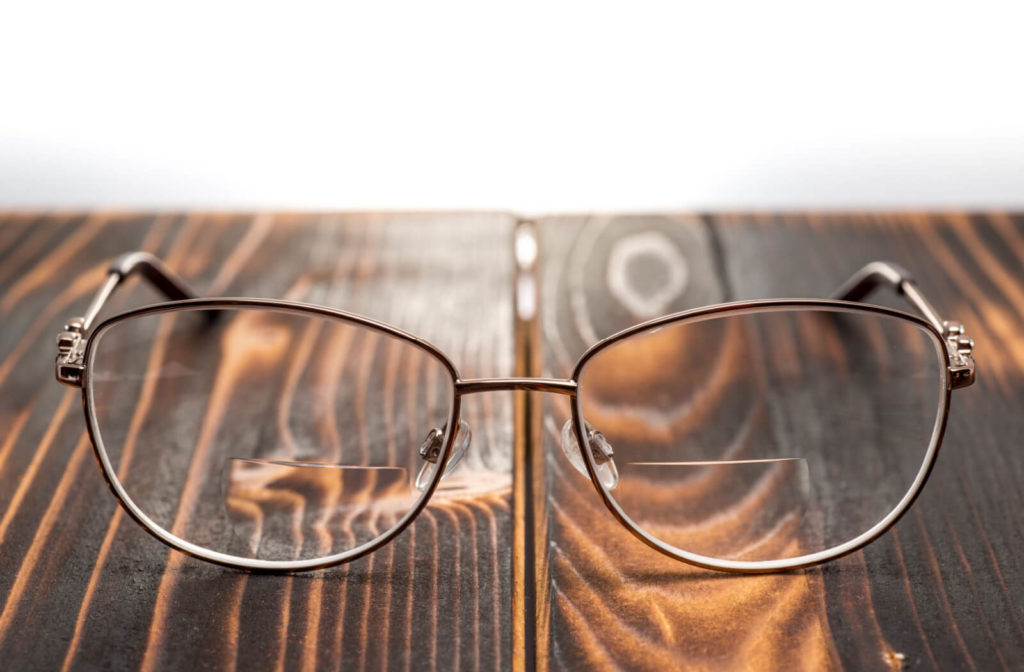It’s not uncommon for someone to get mixed up and use the terms bifocal and progressive lenses interchangeably. But even though they do similar things, each of these prescription lenses has significant differences from the other. Design, purpose, and price are three major differences that make each lens ideal for different people.
Suppose your optometrist thinks you may benefit from one of these lenses after examining your eyes. In that case, they will likely ask you some questions to confirm your vision needs. Then they can give you their recommendation on which lens best suits your lifestyle.
Difference Between Progressive Lenses and Bifocals
On the surface, these two lenses do a similar job in that they each correct for multiple refractive errors.
The first and most obvious difference between them is how they look. A bifocal has an obvious line that separates where the prescription changes. Whereas a progressive lens is one piece with no division.
Because a progressive lens is one continuous lens, it corrects near, far, and intermediate focus. But a bifocal simply corrects near and far. However, it’s possible to get trifocal lenses. Though, they are less popular.
The other significant difference between the two is price. In most cases, a progressive lens costs quite a bit more than a bifocal. But progressives have a lot of added value when evaluating the cost.
Reason for These Lenses
As we age, it’s normal for our eyes to change to a certain degree. Some people’s vision doesn’t change enough to cause any issues. For example, suppose someone doesn’t need glasses to see things at a distance. In that case, they may simply need a pair of reading glasses for close-up tasks due to developing presbyopia (farsightedness).
However, if someone already wears glasses to correct myopia (nearsightedness) because they can’t focus on distant objects, they would need a second pair of glasses. After 40, the risk of developing farsightedness goes up, and they could need glasses to correct two different refractive errors. This is where someone would benefit from a bifocal or progressive lens.
Alternative Options
Suppose you’re not ready to jump into using either of these lenses. In that case, there are a couple of potential alternatives you can discuss with your optometrist.
- Reading glasses: Because farsightedness only affects your focus on faraway objects, reading glasses are often an alternative. But it can be inconvenient to switch your eyewear back and forth based on your task.
- Multifocal contact lenses: These special contact lenses have multiple prescriptions on each lens. They are similar in function to a progressive lens.
- Monovision contact lenses: Each eye has a different prescription—one for distance and the other for close-up tasks.
Considerations for Choosing One or the Other
Progressive lenses seem to be the more popular choice in most cases nowadays. However, they aren’t for everybody. Let’s look at a few things to consider when it comes to choosing a lens:
- Price: If budget is the primary concern, a bifocal lens is likely the best option. However, it’s worth mentioning that many progressive lenses are available in different qualities for some price flexibility. Your optometrist can work with you to find the best lenses for your budget.
- Vision needs: Do you spend a lot of time on the computer? This is considered intermediate vision, so a bifocal will be more of a hindrance than it’ll help. On the other hand, if you cannot go through a lengthy adjustment period for any reason, a progressive lens typically takes longer to adjust to.
- Aesthetic: If we’re being honest, style is a big part of eyewear—even prescription glasses. Just because we need to wear glasses for proper vision doesn’t mean we should have to sacrifice style. In this case, a progressive is a more desirable lens because they have no visible difference.
Getting Used to New Lenses
No matter which lens you choose, there will be a certain degree of getting used to them. Here are a few tips to help you ease into your new lenses quickly:
- Avoid looking down at your feet while walking.
- While reading, move the material up and down as you read instead of moving your head.
- Keep your reading material approximately 16 inches from your face and ensure you look at it through the lower portion of your lenses.
- Even if you don’t need your new lenses every day, wear them continuously for the first couple of weeks so your eyes have a chance to adjust.
- Avoid switching back and forth between your new multifocal lenses and your old glasses.
- Ensure your frames sit on your face properly, so the lenses are positioned correctly in front of your eyes.
Finding out More About Lens Options
If you’ve noticed it’s getting hard to read close-up things, you may be developing farsightedness. A pair of reading glasses can be a reasonable solution in many cases. However, if the vision changes interrupt your life, it’s a good idea to talk to your eye doctor.
Give us a shout at Aurora 2020. The helpful staff is happy to answer your questions and get you in to see the optometrist at a convenient time.



